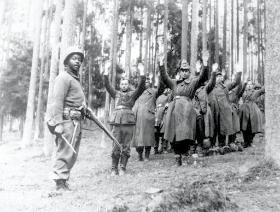It’s always enlightening to dive into the military’s historical archives, because armies have been doing the same things for hundreds of years. While the troops in charge today might think they’re blazing a new trail, chances are good soldiers a generation or two earlier traveled the same path, now overgrown with the passage of time.

A black U.S. Army soldier guards Nazi troops, April 1945 / DoD
Take the coming end of “Don’t Ask, Don’t Tell.” For months, we’ve heard the political axes swinging into the timber of opposition. You’ve been able to see the top of the tree shake, white chunks of freshly-cut wood spewing from the trunk with every blow. Even the 9th U.S. Circuit Court of Appeals action late Wednesday saying that the ban can remain in place — at least for now reversing a lower court ruling terminating “Don’t Ask, Don’t Tell” — only seems likely to delay the inevitable.
“My gosh,” some folks fret. “How will the military ever deal with allowing openly gay men and women to serve in uniform?” Actually, pretty much the same way it dealt with the integration of black soldiers into a white Army 60 years ago.
Take Integration of Negro and White Troops — U.S. Army, Europe, 1952-1954, written by Army historians in 1956, for example.
This was the lay of the land, according to the report, when President Truman ordered the armed forces integrated in July 1948:
The official policy of the U.S. Army since the Civil War had been to keep the white and Negro races segregated in separate units. Negro soldiers had been assigned to Negro units of regimental size or larger, some of which had Negro officers. Most Negroes had been employed in service support functions because they had generally been regarded as unsuitable for combat.
So the Army began to comply, slowly and secretly:
The Korean conflict erupted in June 1950, only a few months after the removal of racial quotas for enlistments; this was about the time that Negroes were first integrated into white training units…The recommendation was made to integrate Negroes into all units up to 15 percent of strength with implementation to take place through normal attrition and replacement processes. On the basis of the limited integration that had already taken place in Korea, the FECOM Assistant Chief of Staff, G1, concluded that colored soldiers could and did fight well when integrated.
Then came the push to integrate the U.S. Army in Europe:
In the summer of 1951 the Department of Defense sent Dr. Eli Ginzberg, Columbia University professor and sometime Army consultant on manpower, to Europe to inform the senior officers in Heidelberg of the integration progress made elsewhere and to consult with them on the preparation of a similar program in Europe. Upon his arrival, Dr. Ginzberg encountered doubt that integration in the United States and Far East had been successful. Even if true, integration would not advance beyond the planning stage in Europe, and if implemented, it would probably be unsuccessful. Some officers were not aware of the progress made by integration elsewhere; they thus reflected the Army’s success in having kept the program classified.
(Kind of makes you wonder if somewhere — maybe in the wilds of 636,000-acre Fort Irwin, in California’s Mojave Desert — the Army hasn’t secretly combined straights and gays into a couple of brigades to see if they can get along.)
Anyway, despite such concerns, integration happened and national security wasn’t hurt:
The standard guides for determining whether appropriate levels of performance and effectiveness have been reached are the various unit training tests and inspections. The results of these tests [Army Field Forces (AFF) Army Training Tests (ATT)] and the reports of these inspections [Annual General Inspections (AGI’s) and Command Maintenance Inspections (CMI’s)] in the integrated units showed generally that integration had raised the level of performance of former all-Negro units and had improved their capability to perform their mission. Moreover, integration had not decreased the combat effectiveness of former all-white units.
Within a few years, I’m sure Army historians will churn out a new report detailing the integration of gays into the U.S. military. I have a sneaking suspicion its bottom line will say something like this:
Moreover, integration had not decreased the combat effectiveness of former all-straight units.


